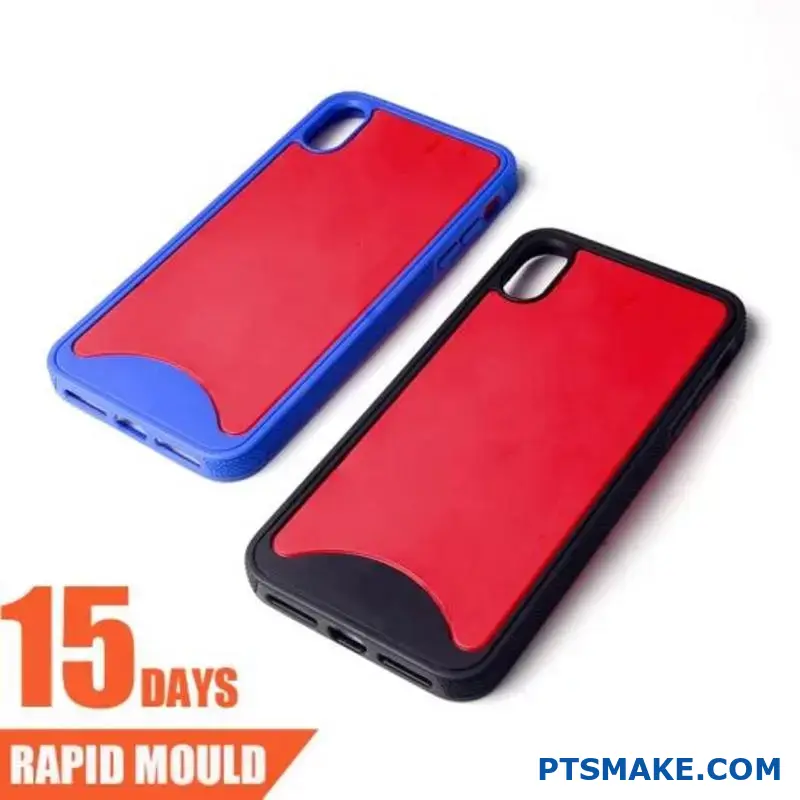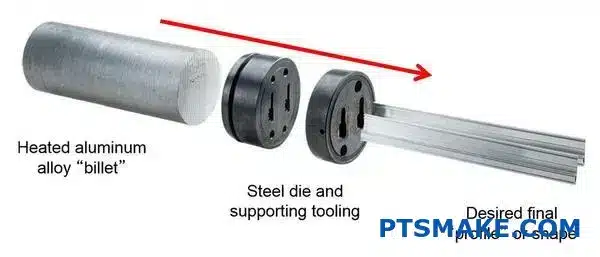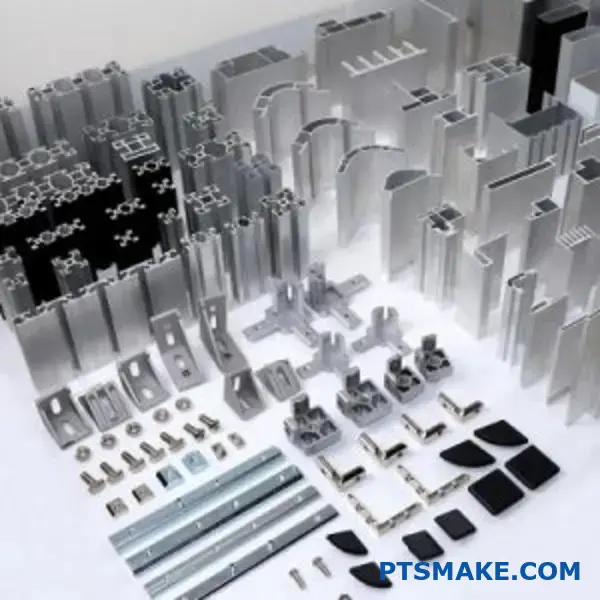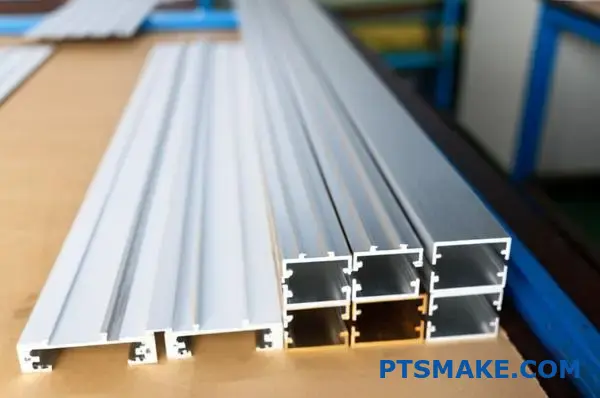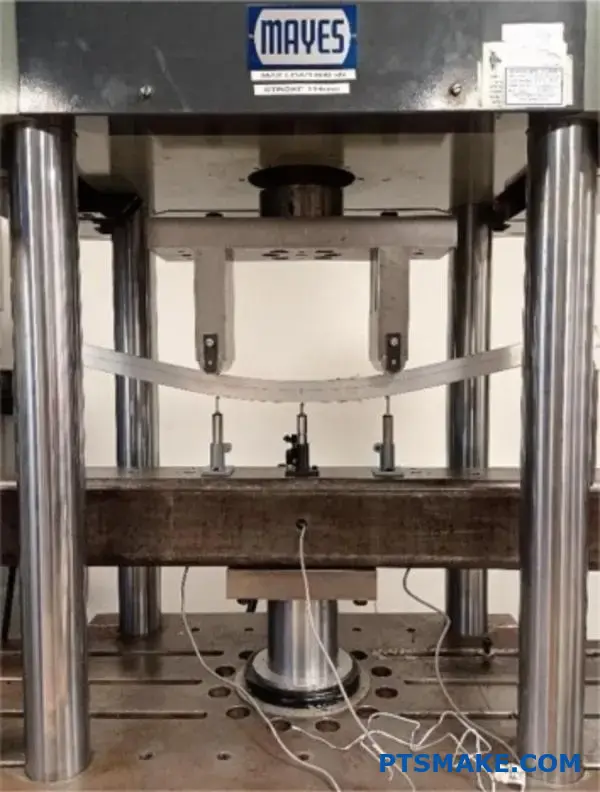Ever faced a project delay because your custom parts took weeks to arrive? Or struggled with inconsistent quality that forced last-minute redesigns? These frustrations hit harder when deadlines loom and budgets shrink. Aluminum profiles promise efficiency, but unreliable suppliers often turn potential solutions into new headaches.
An aluminum profile is a shaped metal extrusion created by forcing heated aluminum through a die. These lightweight, corrosion-resistant components form structural frameworks in industries like automotive, aerospace, and robotics.
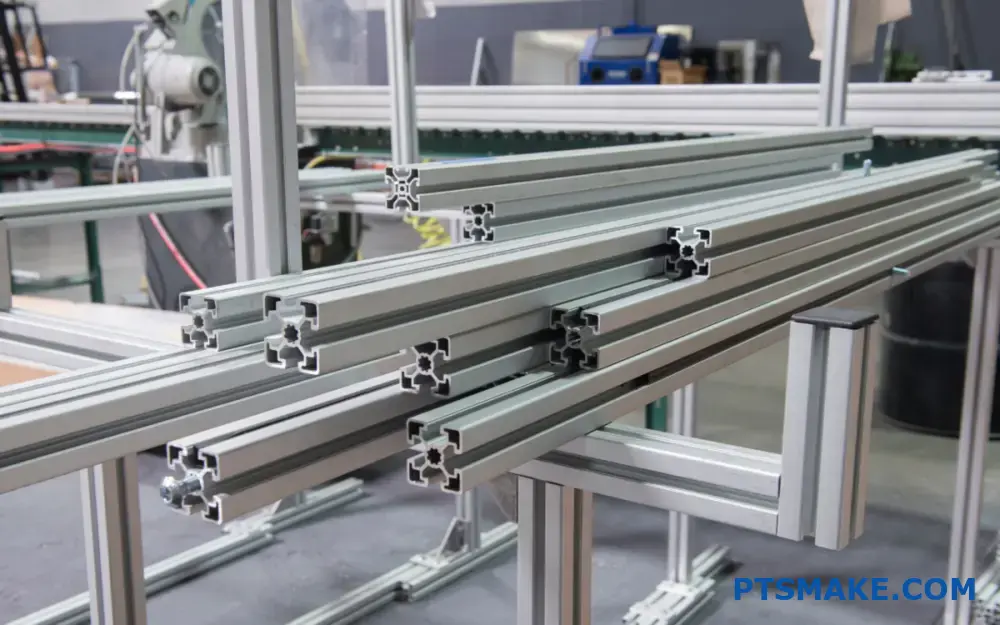
You might think all aluminum profiles are interchangeable—until a mismatched tolerance derails your assembly line. The truth? Not every supplier understands how alloy grades, surface treatments, and thermal properties impact real-world performance. Let’s break down what makes aluminum profiles work (or fail) in critical applications, and how to avoid costly missteps.
How Strong Is An Aluminium Profile?
Have you ever designed a product only to discover your aluminum frame bends under unexpected loads? Or worse – faced costly delays because the material’s strength didn’t match your calculations? These frustrations aren’t just inconvenient; they expose critical gaps in understanding what aluminum profiles can truly handle.
Aluminum profiles achieve strengths ranging from 70 MPa to 600 MPa, depending on alloy composition, tempering processes, and structural design. Their strength-to-weight ratio often outperforms steel in applications demanding lightweight durability, but only when engineered correctly.
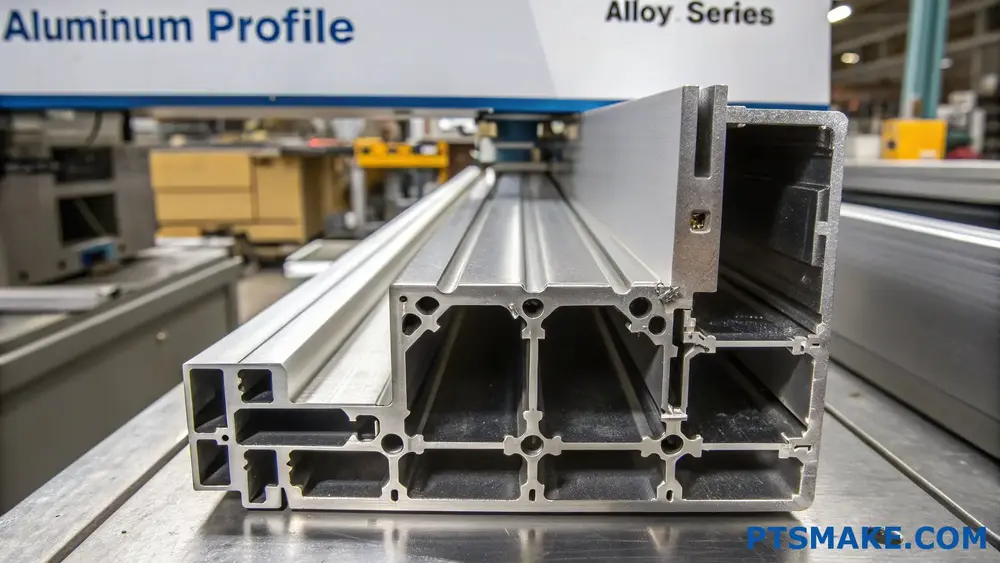
Breaking Down Aluminum Profile Strength
1. The Science Behind the Metal
Aluminum derives its strength from atomic bonding and dislocation movement1. Pure aluminum is soft, but adding elements like magnesium or silicon disrupts these dislocations, making the material harder. For example:
| Alloy Series | Key Elements | Typical Tensile Strength (MPa) | Common Applications |
|---|---|---|---|
| 6000 | Mg, Si | 150-310 | Structural frames |
| 7000 | Zn | 350-600 | Aerospace components |
| 1000 | None (99%+ Al) | 70-110 | Decorative trims |
At PTSMAKE, we’ve machined profiles across these alloys for robotics and medical devices. A recent project required a 7075-T6 aluminum arm for an industrial robot – it needed to withstand 480 MPa stresses while weighing 40% less than steel alternatives.
2. How Geometry Multiplies Strength
A profile’s shape isn’t just about aesthetics:
- Hollow vs. Solid: Hollow sections reduce weight without sacrificing rigidity. A 50x50mm hollow profile resists bending 3.2x better than a solid rod of equal weight.
- Rib Placement: Strategically placed ribs (as thin as 1.5mm in our CNC-machined prototypes) can increase torsional stiffness by 70%.
3. The Hidden Weakness: Thermal and Chemical Factors
Aluminum’s strength drops by 15-25% at 150°C. We once redesigned a automotive sensor mount after discovering ambient engine heat softened the original 6061-T6 profile. Similarly, salty environments accelerate corrosion unless anodized or coated – a lesson learned from coastal robotics projects.
4. Testing Methods That Matter
Don’t rely solely on datasheet values:
- Hardness Testing: Quick but superficial (e.g., Brinell scale)
- Tensile Testing: Reveals true yield and ultimate strength
- Fatigue Testing: Critical for parts undergoing cyclic loads
Our lab uses digital image correlation to map stress distribution – a technique that exposed uneven load paths in a drone frame, prompting a redesign that doubled its lifespan.
5. When Stronger Isn’t Better
High-strength alloys like 7075 cost 2-3x more than 6061 and are harder to machine. For a consumer electronics housing project, switching from 7075 to 6061 saved 22% in material costs without impacting performance – because the design utilized smart ribbing instead.
How Many Types Of Aluminium Profiles Are There?
Have you ever faced unexpected project delays because you chose the wrong aluminum profile? Or discovered mid-production that your selected alloy can’t handle the required load capacity? These frustrations aren’t just inconvenient – they can derail timelines and blow budgets.
There are 4 primary classification methods for aluminum profiles: by alloy composition, cross-sectional shape, surface treatment, and industrial application. Each category contains multiple subtypes designed for specific performance requirements and use cases.
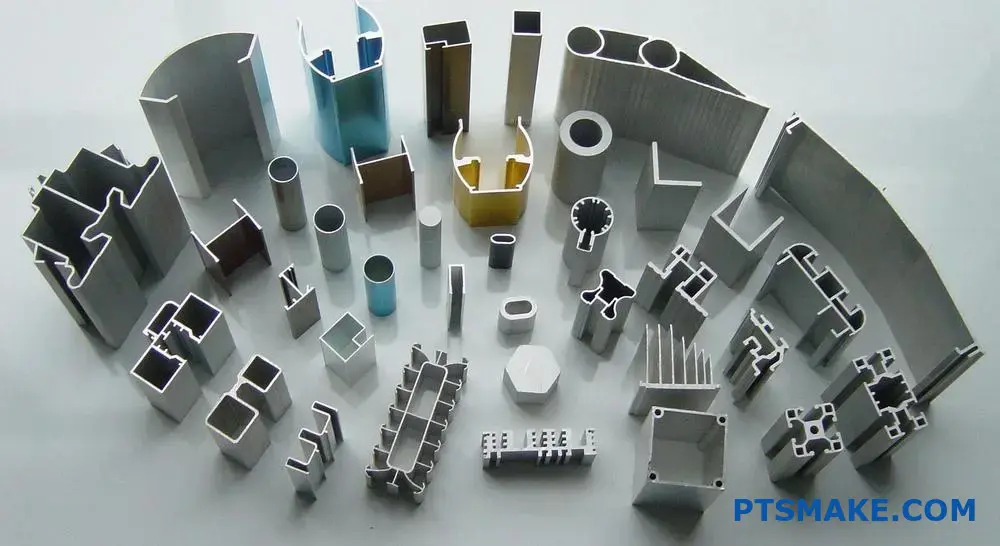
Breaking Down Aluminum Profile Classifications
Let’s examine each classification system through the lens of practical manufacturing needs:
1. Alloy Composition Differences
The aluminum alloy series determines fundamental material properties. At PTSMAKE, we regularly work with these key types:
| Series | Key Elements | Tensile Strength | Typical Use |
|---|---|---|---|
| 1000 | 99%+ Al | 70-110 MPa | Decorative trims |
| 6000 | Mg + Si | 150-310 MPa | Structural frames |
| 7000 | Zn + Mg | 350-500 MPa | Aerospace components |
The 6000 series (particularly 6061 and 6063) accounts for 68% of industrial profiles due to its optimal balance of strength and formability. However, we’ve found that many clients overlook the benefits of precipitation hardening2 in 7000 series alloys for high-stress applications.
2. Cross-Sectional Geometry Options
Profile shapes directly impact functionality and assembly efficiency:
Standard Shapes
- T-slot extrusions (modular framing systems)
- I-beams (structural support)
- U-channels (edge protection)
Custom Shapes
We recently developed a hollow-core hexagonal profile with internal cooling channels for a robotics client, reducing component weight by 40% compared to solid aluminum parts.
3. Surface Treatment Methods
Different finishes serve distinct purposes:
| Treatment | Thickness | Corrosion Resistance | Cost Factor |
|---|---|---|---|
| Anodizing | 5-25 μm | Excellent | $$$ |
| Powder Coating | 60-120 μm | Good | $$ |
| Mechanical Polishing | N/A | Poor | $ |
For medical equipment projects, we often recommend electropolishing – a process that removes surface impurities while improving microbial resistance2.
4. Application-Specific Designs
Different industries require specialized profiles:
Architectural
Thermal break systems with polyamide inserts (0.24 W/m·K thermal conductivity)Automotive
Crash management systems using AA7003 alloys (energy absorption up to 35 kJ)Electronics
EMI-shielded enclosures with conductive coatings (60 dB attenuation at 1 GHz)
Our team recently helped a client redesign their solar panel mounting system using 6063-T6 profiles, reducing installation time by 30% while maintaining IEC 61215 certification requirements.
Critical Selection Factors
When advising clients at PTSMAKE, we emphasize three often-overlooked considerations:
Thermal Expansion Compatibility
Aluminum’s 23 μm/m·°C expansion rate must align with joined materials
Example: Stainless steel fasteners (17 μm/m·°C) require thermal compensationMachining Allowances
Recommended tolerances for common processes:Process Tolerance (±) CNC Milling 0.05 mm Drilling 0.1 mm Laser Cutting 0.2 mm Regulatory Compliance
- ASTM B221 for general extrusions
- AMS 4152 for aerospace applications
- EN 755-9 for European markets
Our ISO 9001-certified facility maintains separate production lines for medical-grade (ISO 13485) and automotive (IATF 16949) profiles to prevent cross-contamination – a crucial detail many suppliers overlook.
Where Are Aluminium Profiles Used?
Have you ever faced a project where material flexibility and structural integrity couldn’t coexist? Or struggled to balance lightweight design with durability in industrial applications? These challenges are common, but what if there’s a material that solves them all?
Aluminum profiles are extruded shapes used across industries for their lightweight strength, corrosion resistance, and design flexibility. From building facades to electric vehicle battery trays, they enable cost-effective, sustainable solutions for complex engineering needs.
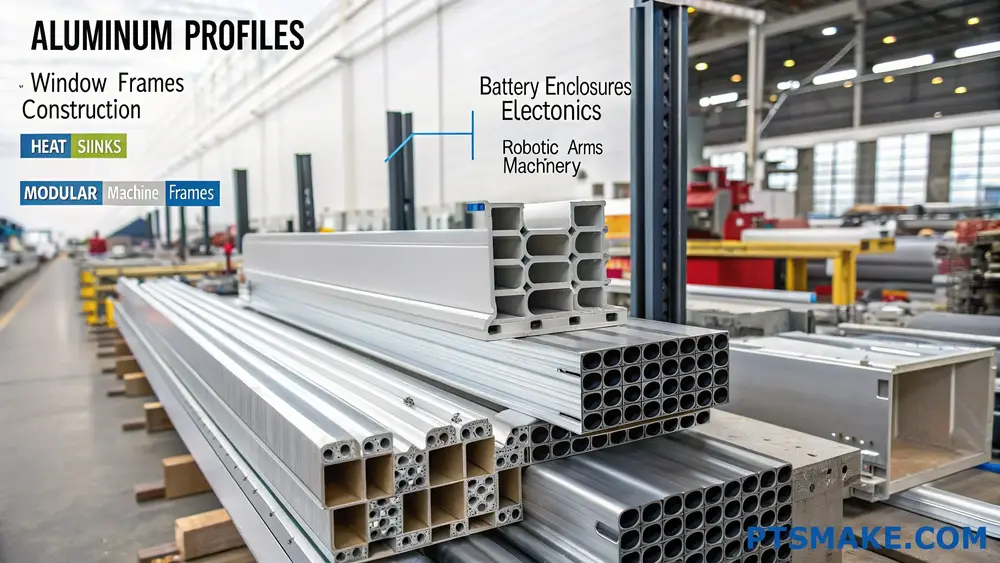
Key Industries Leveraging Aluminum Profiles
1. Construction & Architecture
Aluminum profiles dominate modern construction due to their adaptability and longevity.
Applications:
- Curtain walls and window frames: Their corrosion resistance ensures decades of service in harsh weather.
- Structural supports: High strength-to-weight ratios reduce load on buildings while maintaining safety.
- Solar panel mounting systems: Lightweight yet durable enough to withstand environmental stress.
At PTSMAKE, we’ve supplied custom aluminum profiles for skyscraper projects in Europe, achieving tolerances as tight as ±0.05mm for seamless assembly.
2. Automotive & Transportation
The shift toward electric vehicles (EVs) has skyrocketed aluminum profile demand.
Critical Uses:
| Application | Aluminum Grade | Key Advantage |
|---|---|---|
| EV battery enclosures | 6061-T6 | Thermal management & crash safety |
| Chassis components | 7075 | Weight reduction without strength loss |
| Heat sinks | 6063 | Optimized thermal conductivity3 |
Our team recently developed a modular battery tray system using 6061-T6 profiles, reducing a client’s assembly time by 30% while cutting weight by 15% versus steel alternatives.
3. Electronics & Robotics
Precision is non-negotiable here. Aluminum profiles provide:
- EMI shielding for sensitive components
- Heat dissipation for high-performance processors
- Rigid frames for collaborative robots
A robotics startup we partnered with needed a 2-meter robotic arm profile with 12 internal cooling channels. Using CNC-machined 6063 aluminum, we achieved a 0.1mm straightness tolerance critical for positional accuracy.
4. Industrial Machinery
Aluminum’s machinability makes it ideal for custom machine frames, conveyor systems, and automation equipment.
Why Engineers Choose Aluminum:
- Modularity: T-slotted profiles allow rapid reconfiguration.
- Hygiene: Non-porous surfaces meet FDA standards for food/pharma.
- Cost efficiency: Lower machining costs vs. stainless steel.
Design Considerations for Aluminum Profiles
Material Selection Guide
| Requirement | Recommended Alloy | Notes |
|---|---|---|
| High strength | 7075 | Aerospace-grade, less corrosion-resistant |
| Welding compatibility | 6061 | Requires post-weld heat treatment |
| Anodizing finish | 6063 | Superior surface uniformity |
Tolerance Standards
- Commercial: ±0.5mm (structural applications)
- Precision: ±0.1mm (robotics, optics)
- High-Accuracy: ±0.05mm (PTSMAKE’s specialty for medical/automotive)
Sustainability Factors
Aluminum profiles support circular manufacturing:
- 95% recyclability without property loss
- Lower carbon footprint vs. virgin material production
- Lightweighting reduces transportation emissions
A 2023 study showed that using recycled aluminum profiles in EV production cuts lifecycle emissions by 72% compared to traditional methods.
Why Partner with PTSMAKE?
- Speed: 5-7 day lead time for prototypes via our Shenzhen facility.
- Scale: Annual production capacity of 12,000+ metric tons.
- Certifications: ISO 9001, IATF 16949, and AS9100D compliant.
Last quarter, we delivered 8,000 CNC-machined aluminum housings for a German medical device manufacturer, maintaining 99.98% defect-free quality across 14 critical dimensions.
From concept to production, aluminum profiles offer unmatched versatility. Whether you’re designing a zero-energy building or a next-gen robot, understanding their applications ensures smarter material choices. At PTSMAKE, we combine two decades of aluminum expertise with cutting-edge extrusion and machining technologies to turn your designs into reality—fast, precise, and cost-effectively.
What Are The Key Quality Standards For Aluminum Profiles?
Have you ever received aluminum profiles that warped under minimal stress? Or faced costly rework because dimensions didn’t match specifications? These aren’t just annoyances—they’re symptoms of ignoring critical quality benchmarks.
Aluminum profiles must meet strict standards for chemical composition, mechanical properties, dimensional tolerances, surface finish, and corrosion resistance. Key certifications include ASTM B221, EN 755, and ISO 6361, which ensure consistency across industries like aerospace and automotive.
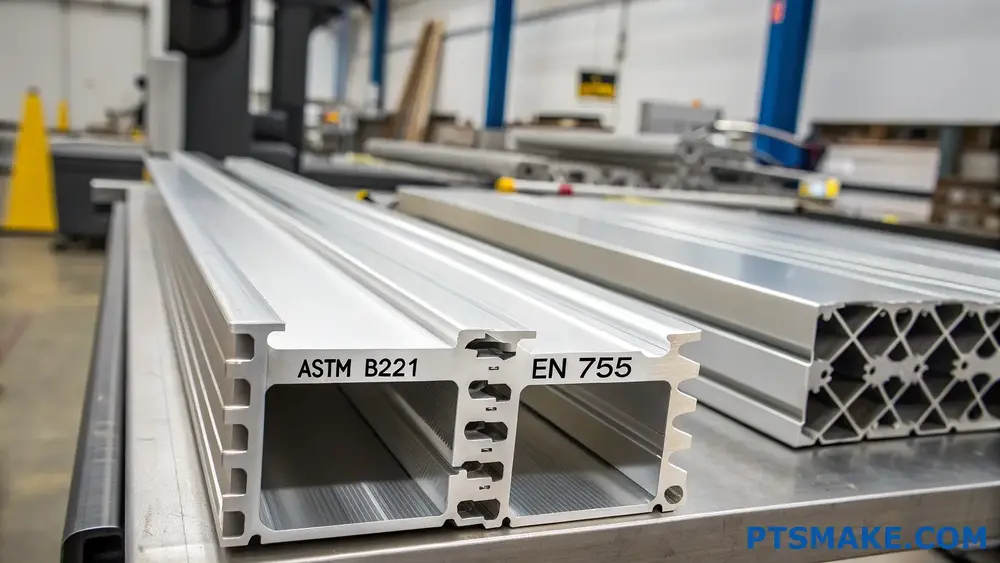
Breaking Down the Critical Quality Benchmarks
1. Chemical Composition: The Foundation of Performance
Aluminum alloys derive their properties from precise elemental ratios. Even minor deviations can compromise strength or corrosion resistance.
Key Elements to Monitor:
| Element | Role in Aluminum Alloys | Acceptable Range (Example: 6061-T6) |
|---|---|---|
| Magnesium (Mg) | Enhances strength | 0.8–1.2% |
| Silicon (Si) | Improves castability | 0.4–0.8% |
| Copper (Cu) | Increases hardness | 0.15–0.40% |
At PTSMAKE, we use optical emission spectrometers to verify compositions within ±0.05% of target values. This precision prevents issues like stress corrosion cracking in marine applications.
2. Mechanical Properties: Beyond Basic Strength
Tensile strength and yield points matter, but real-world performance requires deeper analysis.
The Hidden Factor: Strain Hardening Exponent
This rarely discussed metric (denoted as n) determines how aluminum distributes stress during forming. A higher n value (0.25–0.35 for 6061-T6) allows complex bends without cracking—critical for automotive frame components.
3. Dimensional Tolerances: Where Precision Meets Practice
The tightest tolerances aren’t always better. Consider functionality vs. cost:
| Profile Type | Critical Tolerance Zones | Industry Standard |
|---|---|---|
| Structural beams | Mounting surfaces | ±0.5mm/m |
| Heat sinks | Fin spacing | ±0.1mm |
| Automotive rails | Cross-sectional flatness | ±0.2mm over 1m |
For a robotics project last year, we achieved ±0.05mm repeatability on CNC-machined aluminum guides by combining extrusion with secondary machining—a hybrid approach that cut costs by 18% versus full CNC production.
4. Surface Integrity: More Than Cosmetic
Anodizing thickness standards often overshadow subsurface defects. Our quality checks include:
- Microhardness testing (80-100 HV for 6063-T5)
- Eddy current inspection for cracks below 0.1mm depth
- Salt spray testing exceeding 1,000 hours for marine-grade parts
5. Traceability: The Unseen Safety Net
Modern manufacturing demands full pedigree tracking:
- Mill test certificates for raw billets
- Heat treatment batch records
- Dimensional inspection reports per ISO 9001
We embed QR codes directly on profiles, allowing clients like medical device manufacturers to access full histories instantly.
When Standards Collide: Navigating Conflicting Requirements
A recent aerospace project required:
- AMS 2772 heat treatment (140°C aging)
- EN 12258-3 chemical limits
- AS9100 traceability
By modifying the solution heat treatment4 sequence and adding a final cold-stretching step, we met all three standards without compromising cycle times.
The Cost-Quality Balance Sheet
| Quality Investment | Upfront Cost | Long-Term Savings |
|---|---|---|
| Precision dies | +15% | -30% scrap rate |
| Automated inspection | +8% | -45% returns |
| Certified materials | +12% | +20% product lifespan |
A client in renewable energy saved $220k annually by upgrading from commercial-grade to ASTM-certified aluminum profiles, despite a 10% material cost increase.
Why Most Suppliers Fail at Consistency
Through 15+ years in precision manufacturing, we’ve identified three systemic gaps:
- Inadequate billet pre-heating: Causes uneven grain structure
- Over-reliance on end-of-line testing: Misses process drift
- Ignoring ambient humidity: Affects aging oven performance
Our solution? Real-time process monitoring with AI-driven adjustments—reducing dimensional variances by 63% compared to traditional methods.
How To Choose The Right Aluminum Profile Supplier?
Have you ever faced unexpected project delays because your aluminum profile supplier couldn’t meet specifications? Or discovered hidden costs after placing orders? These frustrations aren’t just inconveniences – they can derail entire production schedules and damage client relationships.
Choosing the right aluminum profile supplier requires evaluating technical capabilities, quality control systems, and supply chain reliability through a structured approach. The ideal partner combines material expertise with manufacturing flexibility to meet both precision and scalability demands.
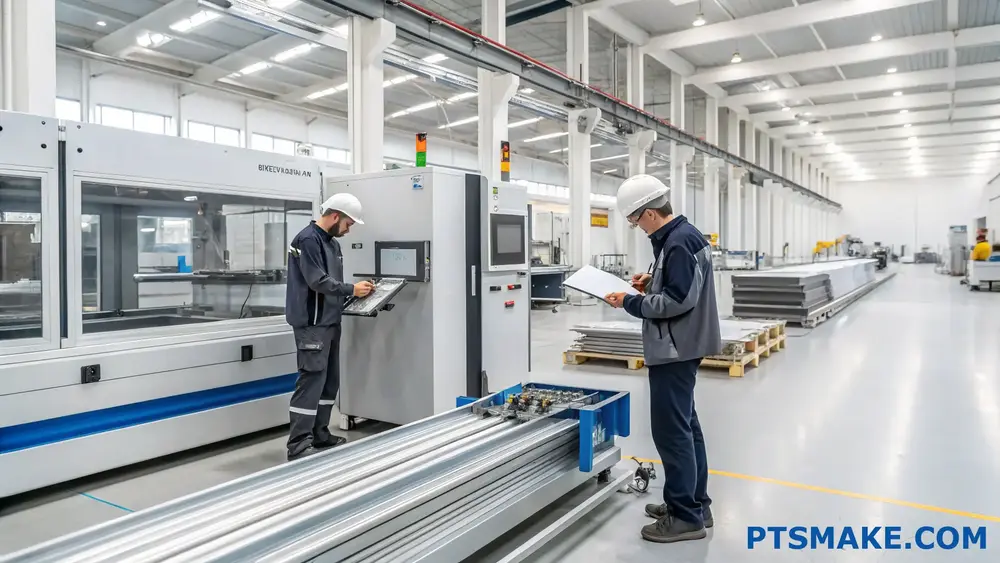
Key Evaluation Criteria for Aluminum Profile Suppliers
3 Technical Capabilities That Matter
Material Certification Compliance
- Verify certifications for:
- ISO 9001 (Quality Management)
- IATF 16949 (Automotive)
- AS9100 (Aerospace)
- At PTSMAKE, we maintain 14 material certifications including EN 9100 and ISO 13485 for medical applications
- Verify certifications for:
Profile Complexity Handling Capability Basic Supplier Advanced Supplier Wall thickness <1mm Limited Full production Tight tolerances (±0.05mm) Manual checks Laser measurement Surface finish options <5 types 12+ treatments Customization Capacity
- Look for suppliers offering:
- CAD/CAM integration
- Rapid prototyping (3-5 day turnaround)
- Post-processing5 customization
- Look for suppliers offering:
4 Operational Red Flags to Identify
Hidden Cost Triggers
- Tooling fees exceeding 15% of initial quote
- MOQs requiring 30%+ excess inventory
- Unspecified packaging/shipping charges
Quality Control Gaps
- Missing documentation for:
- Raw material traceability
- Dimensional inspection reports
- Surface treatment validation
- Missing documentation for:
Communication Breakdowns
- Response time >4 business hours
- No dedicated project manager
- Limited English proficiency in technical teams
Scalability Limitations
- Production capacity <5,000 units/month
- Single-source material procurement
- No contingency planning for raw material shortages
5 Partnership Indicators
Technical Collaboration Process
- Preferred workflow:
- Design review (DFM analysis)
- Prototype validation
- Process optimization
- Full-scale production
- Preferred workflow:
Problem Resolution Framework
- Effective suppliers should provide:
- Root cause analysis within 24hrs
- Corrective action plan in 48hrs
- Preventative measures implementation
- Effective suppliers should provide:
Value-Added Services
- Inventory management programs
- Just-in-time delivery options
- Annual cost reduction initiatives
At PTSMAKE, we’ve developed a proprietary anodization process that increases aluminum profile corrosion resistance by 40% compared to standard treatments. This innovation came from solving repeated field failures in marine environment applications – a challenge many suppliers still struggle to address effectively.
What Surface Treatments Are Available For Aluminum Profiles?
Have you ever spent weeks designing a perfect aluminum profile, only to watch it corrode within months? Or faced unexpected costs when your anodized parts develop uneven coloring after assembly? These frustrations aren’t just annoying—they can derail timelines, inflate budgets, and damage your product’s reputation.
Aluminum profiles can be treated with seven key surface treatments: anodizing, powder coating, electrophoretic deposition, chemical conversion coating, mechanical finishing, electroplating, and PVDF coating. Each method balances corrosion resistance, aesthetics, durability, and cost for industrial applications.
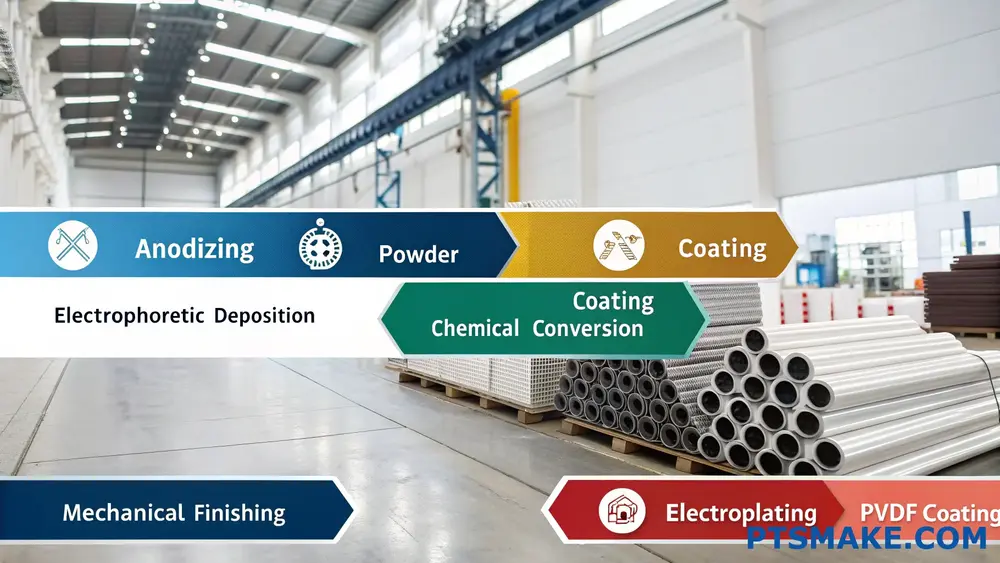
Comparing Surface Treatment Methods for Aluminum Profiles
1. Anodizing: The Industry Standard
Anodizing creates a controlled oxide layer through electrolysis. At PTSMAKE, we’ve optimized this process for aerospace and medical clients who demand tight tolerances (±0.005 mm) and uniform finishes.
| Types of Anodizing | Type | Thickness (μm) | Key Features | Best For |
|---|---|---|---|---|
| Type II | 5-25 | Decorative, dyeable | Consumer electronics | |
| Type III | 25-150 | High wear resistance | Hydraulic systems | |
| Hardcoat | 50+ | Extreme hardness (60-70 Rockwell C) | Marine equipment |
A robotics client recently switched from Type II to Hardcoat anodizing after their CNC-machined actuator housings showed premature wear. The redesign extended service life by 300% but added 18% to material costs—a tradeoff we helped them model using finite element analysis6.
2. Powder Coating: Color Without Compromise
Unlike liquid paints, powder coatings cure through polymerization. Our facility uses tribostatic guns that achieve 95% transfer efficiency—critical when coating complex aluminum extrusions for automotive trim.
Application Considerations
- Preheat profiles to 180°C for improved adhesion
- Limit film thickness to 60-120 μm to avoid cracking
- Use chrome-free pretreatments for EU compliance
3. Electrophoretic Deposition (E-Coating)
This method uses electrical current to deposit paint particles uniformly, even in recessed areas. While common in automotive, we’ve adapted it for aluminum heat sinks in EV battery packs where 0.1 mm coating variations impact thermal performance.
4. Chemical Conversion Coatings
Chromate-free alternatives like zirconium-based coatings now dominate:
| Coating | Corrosion Resistance | Electrical Conductivity | RoHS Compliance |
|---|---|---|---|
| Chromate | Excellent | Poor | No |
| Zirconium | Good | Excellent | Yes |
| Titanium | Fair | Good | Yes |
5. Mechanical Finishing Options
Brushed finishes remain popular, but newer techniques like abrasive flow machining (AFM) can polish internal channels in aluminum manifolds to Ra 0.2 μm—critical for medical fluid systems.
6. Electroplating: When Aluminum Needs to Be Something Else
Nickel plating aluminum requires zincating first. We recently plated drone components with 10 μm of nickel followed by 3 μm of gold, achieving both EMI shielding and connector reliability.
7. PVDF Coatings for Extreme Environments
Fluoropolymer coatings withstand UV, chemicals, and 200°C temperatures. A solar farm project used our PVDF-coated aluminum mounting systems to prevent degradation in desert conditions.
Choosing the Right Treatment: 5 Critical Factors
Environmental Exposure
Salt spray test hours correlate with real-world performance:Treatment 500 hrs 1000 hrs 2000 hrs Anodizing (Type III) No pits <5% pits Failed PVDF Coating No change No change 20% gloss loss Electrical Requirements
Anodized layers are insulators (breakdown voltage ~800 V/μm). For conductive parts, specify non-porous chemical films.Thermal Management
Black anodizing improves heat dissipation by 15-20% over untreated aluminum.Aesthetic Demands
Powder coatings offer 200+ RAL colors, while anodizing is limited to metallics.Budget Constraints
For prototypes, mechanical finishing costs 40% less than full anodizing.
Common Mistakes We’ve Observed
Ignoring Pretreatment
One client skipped alkaline cleaning before powder coating, resulting in 30% adhesion failure. Always:- Degrease
- Etch
- Desmut
Overlooking Thermal Expansion
A 2-meter aluminum facade panel cracked because the coating’s CTE didn’t match the substrate. Match coefficients within 5%.
Future Trends in Aluminum Surface Tech
Laser texturing is gaining traction—our R&D team recently created hydrophobic surfaces with 160° contact angles using femtosecond lasers. This eliminates need for chemical coatings in some applications.
How Does Aluminum Profile Manufacturing Impact Lead Times?
Have you ever faced a project delay because your aluminum components arrived weeks later than promised? What if the very process of creating those sleek, custom profiles is silently eating into your timeline? The reality is, aluminum profile manufacturing isn’t just about shaping metal—it’s a chain of interdependent steps where one bottleneck can derail your entire schedule.
Aluminum profile manufacturing directly impacts lead times through design complexity, extrusion tooling preparation, material sourcing, and post-processing requirements. Optimizing these stages—like using standardized die designs or partnering with vertically integrated suppliers—can reduce delays by up to 40%.

Breaking Down the Lead Time Equation
To understand why aluminum profiles affect project timelines, let’s dissect the manufacturing journey.
Stage 1: Design Validation (5-12 Days)
Every custom profile starts with CAD validation. Even minor design flaws here cascade into costly delays later. For example:
| Design Factor | Time Impact | Cost Multiplier |
|---|---|---|
| Wall thickness <3mm | +3 days (die redesign) | 1.7x |
| Internal channels without draft angles | +6 days (simulation reruns) | 2.4x |
| Non-standard tolerances (±0.05mm) | +4 days (process recalibration) | 1.9x |
At PTSMAKE, we’ve reduced this phase to 72 hours for 80% of projects by using AI-driven design for manufacturability7 checks during prototyping.
Stage 2: Die Development (7-21 Days)
Extrusion dies are the heart of profile manufacturing. Three critical factors dominate this phase:
Die Material Selection
H13 steel dies last longer but take 14 days to machine. Cheaper SKD61 alternatives save 5 days initially but require 30% more maintenance downtime.Tolerance Stack-Ups
A profile requiring ±0.1mm concentricity needs dies with ±0.03mm precision—adding 4 days of CNC grinding.Testing Cycles
First-article extrusion trials often reveal flow imbalances. Our data shows:- 63% of new dies require ≥2 adjustments
- Each adjustment adds 2.5 days
Stage 3: Extrusion Process (3-10 Days)
Here’s where physics meets logistics:
| Speed vs. Quality Tradeoff | Alloy | Max Speed (m/min) | Defect Rate at Max Speed |
|---|---|---|---|
| 6061 | 18 | 12% | |
| 6063 | 22 | 8% | |
| 6005A | 15 | 15% |
Running at 85% max speed cuts defects by half but extends production time by 20%. Our solution? Real-time thermal monitoring to push speeds safely.
Stage 4: Post-Processing (2-15 Days)
Surface treatments often become hidden time sinks:
- Anodizing: 48 hours for Class II (25µm)
- Powder Coating: 72 hours with curing
- Chemical Film (Alodine): 24 hours
For a medical device project last quarter, we saved 11 days by combining mechanical brushing with laser etching instead of traditional anodization.
The Hidden Culprits: What Most Engineers Miss
Four overlooked factors disproportionately affect lead times:
Certification Paperwork
ITAR-compliant aerospace profiles require 7-10 days for documentation alone. Our automated compliance system cuts this to 48 hours.Packaging Complexity
Foam-separated shipping for scratch-sensitive profiles adds 2 days vs. standard palleting.Lot Traceability
Full ASTM E2376 traceability extends QA time by 30% but prevents 92% of post-delivery disputes.Climate Control
Summer humidity in South China adds 18 hours to drying cycles—we offset this with dehumidified production cells.
Case Study: Automotive Battery Housing Timeline
A recent EV battery tray project illustrates how strategic planning compresses lead times:
| Phase | Traditional Timeline | Optimized Timeline |
|---|---|---|
| Design | 14 days | 6 days (DFM concurrent engineering) |
| Die Making | 21 days | 12 days (modular die blocks) |
| Extrusion | 8 days | 5 days (alloy 6061-T6 pre-aged) |
| Machining | 10 days | 7 days (5-axis simultaneous milling) |
| Coating | 9 days | 4 days (UV-cured ceramic coating) |
| Total | 62 days | 34 days (-45%) |
Key takeaway: 72% of the time savings came from upstream decisions—not faster machines.
When Faster Isn’t Better: Quality Check Realities
Rushing aluminum profiles risks catastrophic failures. Last year, a client switched to a “7-day guarantee” supplier. Result?
- 23% of profiles failed ultrasonic testing
- $182k in line downtime
- 6-week recovery delay
Our phased inspection protocol adds 2-3 days but catches 99.6% of defects early:
- 100% dimensional checks after extrusion
- Eddy current testing for cracks
- Salt spray test sampling
Your Lead Time Optimization Checklist
To balance speed and reliability:
- Demand die drawings before quoting
- Specify acceptable surface finish ranges (RA 0.8-3.2µm)
- Pre-approve secondary process suppliers
- Order 10% overage for destructive testing
- Align payment terms with milestone deliveries
At PTSMAKE, we’ve helped clients like Nimble Robotics achieve 98% on-time delivery for custom aluminum profiles—even with 15-day lead times—through integrated process mapping. The secret? Treating lead time reduction as a system, not just a sprint.
What Cost Factors Should Be Considered For Aluminum Profiles?
Have you ever faced unexpected budget overruns when ordering custom aluminum profiles? What if hidden costs—like material waste or delayed deliveries—silently eroded your project’s profitability? These pain points aren’t rare. Engineers and procurement teams often struggle to balance quality, lead time, and cost without a clear framework.
When sourcing aluminum profiles, key cost factors include material grade, extrusion complexity, surface finishing, tooling requirements, order volume, and logistics. Optimizing these elements ensures cost efficiency without compromising performance.
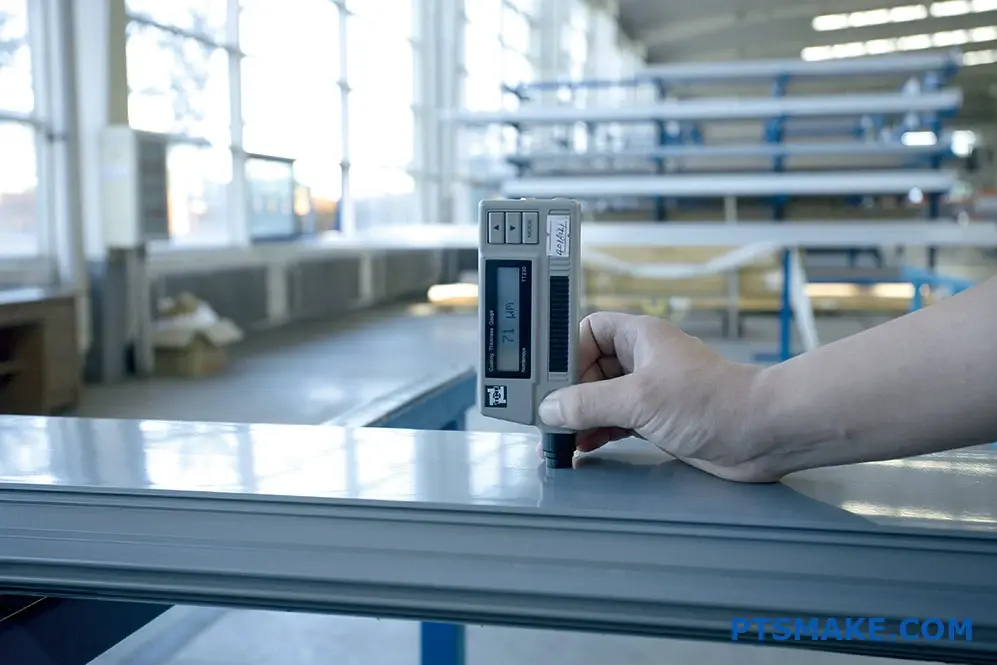
Breaking Down the Cost Drivers
1. Material Selection: More Than Just "Aluminum"
Aluminum alloys vary widely in cost and performance. For example, 6061-T6 is popular for its weldability and strength, while 7075 offers higher tensile strength but costs 30-40% more.
| Alloy Type | Cost per kg (USD) | Common Applications |
|---|---|---|
| 6061-T6 | $3.20–$3.80 | Structural frames, automotive parts |
| 7075-T6 | $4.50–$5.20 | Aerospace components, high-stress fixtures |
| 3003-H14 | $2.90–$3.30 | Decorative trims, HVAC systems |
At PTSMAKE, we use computational material optimization8 to match alloy properties with project requirements, avoiding over- or under-specification.
2. Extrusion Complexity: Geometry Dictates Cost
- Hollow vs. Solid Profiles: Hollow shapes require more complex dies and slower extrusion speeds.
- Tolerance Requirements: Tighter tolerances (±0.1mm vs. ±0.5mm) can increase tooling costs by 15–25%.
- Wall Thickness: Uniform walls below 1.5mm may require specialized presses.
3. Surface Finishing: The Hidden Expense Multiplier
A brushed finish adds $0.80–$1.20 per linear meter, while anodizing Type III (hard coat) costs $2.50–$4.00. For projects needing corrosion resistance, powder coating often provides better ROI than electroless plating.
4. Tooling: One-Time Cost With Long-Term Impact
A basic extrusion die costs $800–$1,500, but profiles with multiple cavities or tight radii can exceed $3,000. For low-volume orders (<5,000 units), consider modular dies to share upfront costs across projects.
5. Order Volume: The Economy of Scale Paradox
While bulk orders reduce per-unit costs, consider:
- Storage costs for excess inventory
- Obsolescence risk for product revisions
- MOQ flexibility (PTSMAKE offers 500-unit batches for prototyping)
6. Secondary Operations: Don’t Overlook Post-Processing
- CNC machining for mating surfaces: $12–$18/hour
- Heat treatment for T6 temper: $1.20–$2.00/kg
- Precision cutting tolerance: ±0.2mm standard vs. ±0.05mm premium
Strategic Cost Optimization Tips
A. Design for Manufacturability (DFM) Early
Involve your supplier during CAD design. Simple changes—like increasing corner radii from 1mm to 1.5mm—can reduce die wear by 40%.
B. Leverage Standard Profiles Creatively
Instead of custom shapes, combine standard U-channels and angles. We helped a robotics client cut costs 22% by redesigning using 80/20 extruded rails.
C. Regional Logistics Math
Shipping 20ft containers from Asia to the US West Coast:
- Standard lead time: 35 days at $2,800
- Expedited: 18 days at $4,500
For urgent orders under 500kg, air freight may cost less than delayed production.
When to Invest in Custom Tooling
Use this decision matrix:
| Order Volume | Profile Complexity | Recommended Approach |
|---|---|---|
| <1,000 units | High | Modify existing dies |
| 1k–5k units | Medium | Modular tooling |
| >5k units | Low | Full custom die |
The Sustainability Factor
Recycled aluminum (Grade 6063) costs 8–12% less than virgin material. With proper computational material optimization8, scrap rates can be reduced from industry-average 15% to under 7%.
At PTSMAKE, we combine ISO 9001-certified processes with AI-driven cost modeling to deliver aluminum profiles that meet both technical specs and budget constraints. Our clients in automation and medical devices consistently achieve 12–18% cost savings through holistic supply chain optimization.
How To Maintain And Extend Aluminum Profile Lifespan?
Have you ever watched aluminum profiles corrode prematurely despite your best efforts? Or struggled with warped structural components that derailed production timelines? These frustrations aren’t just costly – they expose gaps in understanding how aluminum behaves under real-world conditions.
Proper aluminum profile maintenance combines proactive cleaning, protective coatings, load optimization, and environmental control. By addressing surface degradation mechanisms and structural stress patterns, you can extend service life by 40-60% while reducing replacement costs.
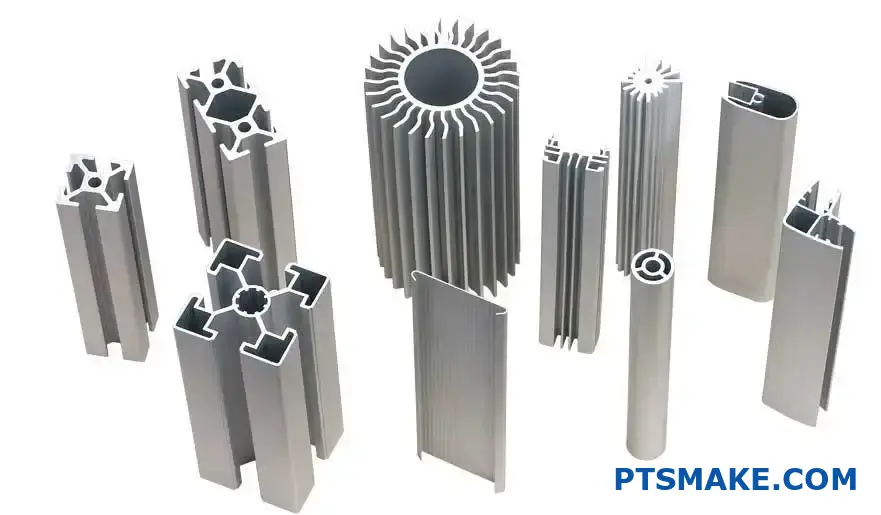
Three Pillars of Aluminum Profile Longevity
1. Surface Protection Strategies
Aluminum’s natural oxide layer provides limited protection. Industrial environments accelerate galvanic corrosion9 through:
| Threat | Impact Depth | Prevention Method |
|---|---|---|
| Saltwater exposure | 0.5-2mm/year | Anodizing + epoxy coating |
| Acidic contaminants | Surface pitting | pH-neutral cleaners |
| Abrasive particles | Scratch pathways | Regular compressed air blow |
At PTSMAKE, we’ve validated that Type III hardcoat anodizing (25-50μm) increases salt spray resistance from 168 hours to 1,000+ hours in marine applications.
2. Structural Load Management
Four critical load factors often overlooked:
2.1 Dynamic vs Static Loading
- Cyclic stress: Aluminum’s fatigue strength drops 30% after 10^7 cycles
- Solution: Finite element analysis (FEA) to identify stress risers
2.2 Thermal Expansion Compensation
- 6061-T6 alloy expands 23.6 μm/m·°C
- Case study: A robotics client reduced joint wear by 62% after implementing expansion gaps calculated using:
Gap (mm) = Length (m) × ΔT (°C) × 0.0236
3. Environmental Control Framework
3.1 Humidity Thresholds
- <60% RH: Safe for most applications
- 60-80% RH: Requires desiccant packs
80% RH: Mandatory climate control
3.2 Chemical Exposure Zones
Our team categorizes risk levels based on airborne contaminants:
| Zone | Contaminant Level | Inspection Frequency |
|---|---|---|
| Green | <5 μg/m³ | Quarterly |
| Amber | 5-20 μg/m³ | Monthly |
| Red | >20 μg/m³ | Weekly |
Maintenance Workflow Optimization
We implement a 4-phase approach for clients:
Baseline Assessment
- Spectrometer analysis of alloy composition
- 3D scanning for existing deformations
Customized Protocol Design
- Match cleaning agents to local pollutants
- Adjust lubrication intervals based on motion cycles
Smart Monitoring Integration
- Corrosion sensors with 0.1mm resolution
- Vibration analysis for early fatigue detection
Lifecycle Documentation
- Digital twin models predicting degradation
- Replacement schedules tied to actual wear data
When Repair Becomes Non-Viable
Through material testing, we’ve identified these failure thresholds:
- Cracks: >0.3mm depth requires replacement
- Corrosion: >3% cross-sectional area loss
- Flatness deviation: >0.15mm per 100mm length
For mission-critical applications like aerospace components, we recommend 20% earlier replacement than these limits.
Cost-Benefit Analysis Example
| Action | Upfront Cost | 10-Year Savings |
|---|---|---|
| Basic powder coating | $1.20/lb | $4.50/lb |
| Plasma electrolytic oxidation | $3.80/lb | $12.70/lb |
| Real-time monitoring system | $15k | $83k |
This data comes from 37 industrial clients we’ve assisted since 2020, showing ROI timelines as short as 11 months.
What Are The Sustainable Practices In Aluminum Profile Production?
Have you ever wondered why some aluminum profile manufacturers consistently deliver eco-friendly products while others struggle with energy waste and environmental fines? What separates sustainable production from greenwashing claims in this highly resource-intensive industry?
Sustainable aluminum profile production combines recycled material integration, clean energy adoption, and closed-loop systems to minimize environmental impact while maintaining industrial-grade performance. Key practices include secondary aluminum smelting, solar-powered extrusion processes, and water recycling technologies that achieve up to 95% resource recovery rates.
Breaking Down Sustainable Aluminum Manufacturing
1. Material Sourcing Revolution
From Mining to Urban Mining
The shift from virgin bauxite to recycled aluminum scrap reduces mining-related deforestation by 42% according to International Aluminum Institute data. At PTSMAKE, we’ve developed a proprietary scrap sorting system that identifies 27 alloy types through laser-induced breakdown spectroscopy10, enabling precise material recovery.
| Material Type | Energy Consumption (kWh/kg) | CO2 Emissions (kg/kg) |
|---|---|---|
| Primary Aluminum | 55 | 11.2 |
| Recycled Aluminum | 5.5 | 0.6 |
Alloy Optimization Strategies
Our engineering team creates custom alloys that maintain mechanical properties while accepting higher impurity thresholds – a crucial factor when using post-consumer scrap. For example:
- Window frame profiles using 80% recycled content
- Automotive structural components with 60% recycled mix
- Aerospace-grade alloys with 30% recycled material
2. Energy Efficiency Breakthroughs
Extrusion Process Innovations
Modern extrusion presses now achieve 30% energy reduction through:
- Variable frequency drive (VFD) motors
- AI-powered heating zone optimization
- Waste heat recovery systems
In our Shenzhen facility, we’ve installed infrared pre-heaters that cut billet heating energy by 18% while improving dimensional accuracy.
Renewable Energy Integration
Solar thermal systems for die heating and photovoltaic arrays for machine operations have become cost-effective solutions. A recent project for a German automotive client combined:
- 2MW rooftop solar installation
- On-site hydrogen fuel cells
- Smart grid integration
This configuration achieved 73% energy independence during daylight operations.
3. Water Management Systems
Closed-Loop Cooling
Advanced water treatment units enable:
- 98% water reuse in extrusion processes
- Zero liquid discharge (ZLD) compliance
- pH-neutral recycling without chemical additives
Our Dongguan plant’s water recovery system processes 5,000 cubic meters daily, equivalent to supplying 20,000 households.
Stormwater Harvesting Techniques
Innovative catchment designs collect and filter rainwater for non-production uses:
- Landscape irrigation
- Cooling tower makeup
- Equipment cleaning
4. Waste Stream Valorization
Byproduct Utilization
Previously landfilled materials now find new applications:
- Aluminum dross → Cement additive
- Cutting sludge → 3D printing powder
- Thermal oil → Road construction material
Packaging Innovations
We’ve replaced single-use wooden crates with:
- Recyclable aluminum collapsible containers
- Mushroom-based biodegradable padding
- RFID-tracked reusable systems
5. Life Cycle Assessment (LCA) Implementation
Modern sustainability requires data-driven decisions. Our team conducts cradle-to-grave analyses that consider:
- Carbon footprint across supply chains
- End-of-life recyclability
- Transportation impacts
For a recent medical equipment project, LCA revealed that localized recycling hubs could reduce overall emissions by 41% compared to centralized processing.
6. Certification and Compliance
Key standards shaping sustainable production:
| Standard | Focus Area | Compliance Benefit |
|---|---|---|
| ASI Performance | Responsible sourcing | EU market access |
| ISO 14001 | Environmental management | Operational efficiency |
| Cradle to Cradle | Material health | Brand differentiation |
Our facilities maintain 12 international certifications, ensuring clients meet stringent sustainability requirements from California’s AB 262 to Germany’s Supply Chain Act.
7. Case Study: Electric Vehicle Battery Frame Production
A recent collaboration with an EV manufacturer demonstrated sustainable practices in action:
- 65% recycled aluminum content
- Solar-powered extrusion line
- Waterless surface treatment
- Closed-loop cutting system
Results:
- 48% lower carbon footprint
- 92% material utilization rate
- 35% faster production cycle
8. Future Trends in Green Aluminum
Emerging technologies set to transform the industry:
- Hydrogen-fired annealing furnaces
- Blockchain material tracing
- AI-driven energy optimization
- Bio-based release agents
At PTSMAKE, we’re currently testing carbon capture systems that mineralize CO2 emissions into raw material for construction industries – a potential game-changer for carbon-negative production.
Learn how dislocation theory impacts your designs – contact PTSMAKE for a free material selection guide. ↩
Learn how advanced surface treatments can enhance your product performance. ↩ ↩
Learn how thermal conductivity impacts EV performance and material selection. ↩
Learn how advanced heat treatment techniques improve aluminum performance in high-stress environments. ↩
Learn how advanced surface treatments improve aluminum profile durability in harsh environments. ↩
Learn how finite element analysis optimizes coating performance in critical applications. ↩
Learn how design for manufacturability cuts aluminum profile lead times by 30% in our free guide. ↩
Learn how computational modeling reduces material waste—click to request a free DFM analysis. ↩ ↩
Galvanic corrosion occurs when dissimilar metals contact in electrolytes. Click to download our corrosion prevention checklist. ↩
Laser-induced breakdown spectroscopy enables precise material identification, crucial for maintaining alloy integrity in recycled aluminum. ↩


